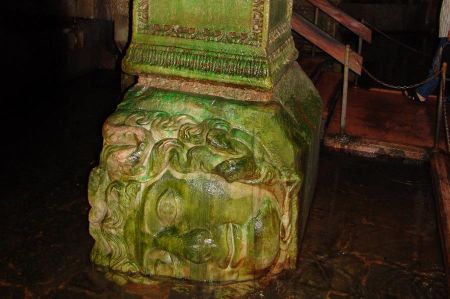Basilica Cistern - Sunken Palace Istanbul
- Written by Portal Editor
The sunken place in Istanbul has a story which is told over the sounds of water. One of the charming constructions left from the Byzantine era is the Basilica Cistern located at Sultanahmet Square in old Istanbul across the street from Hagia Sophia.
The city of old Istanbul had always needed permanent water supplies. As a result of that, many underground cisterns were constructed during the time of the Byzantine Empire (527–565).
Emperor Constantine and Emperor Justinian
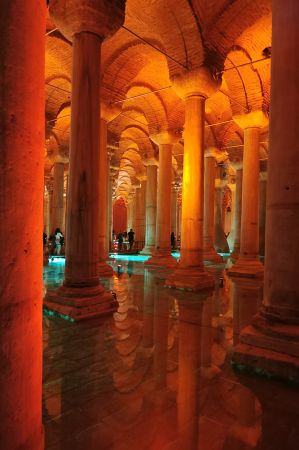 The cistern is said to have originally been commissioned by Emperor Constantine. However, the underground cistern, which is 138 meters long and 65 meters wide, owes its appearance and size to Emperor Justinian. He had the cistern built between 532 and about 542 as a water reservoir for the Grand Palace. Previously there was a basilica at this location, which is why the cistern is also called cisterna basilica. It has a capacity of approx. 80,000 cubic meters of water. Twelve rows of 28, a total of 336 columns, each eight meters high, with mainly Corinthian spolia capitals, support the vault. The water, which came in the best quality from the Belgrade Forest in the highlands north of Istanbul via the Hadrian's Aqueduct and the Valens Aqueduct, was used to supply the imperial household. The facility can be visited. In the water of the cistern, a number of fish, some of them very light to white, can often be observed.
The cistern is said to have originally been commissioned by Emperor Constantine. However, the underground cistern, which is 138 meters long and 65 meters wide, owes its appearance and size to Emperor Justinian. He had the cistern built between 532 and about 542 as a water reservoir for the Grand Palace. Previously there was a basilica at this location, which is why the cistern is also called cisterna basilica. It has a capacity of approx. 80,000 cubic meters of water. Twelve rows of 28, a total of 336 columns, each eight meters high, with mainly Corinthian spolia capitals, support the vault. The water, which came in the best quality from the Belgrade Forest in the highlands north of Istanbul via the Hadrian's Aqueduct and the Valens Aqueduct, was used to supply the imperial household. The facility can be visited. In the water of the cistern, a number of fish, some of them very light to white, can often be observed.
Long since more than a water reservoir
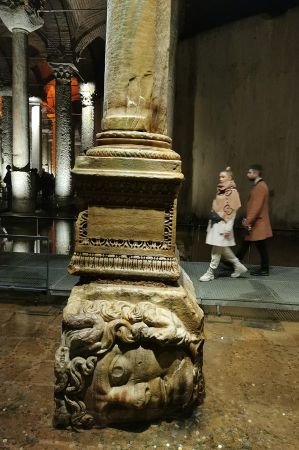 Two pillars in the north-western part of the cistern stand on inverted Medusa heads, which appear to have been transferred here from another location. Their original origin is unknown.
Two pillars in the north-western part of the cistern stand on inverted Medusa heads, which appear to have been transferred here from another location. Their original origin is unknown.
The stone comes from the Prokonesos quarries. The Yerebatan Cistern is now a popular attraction. Light shows are staged and classical music is played over loudspeakers.
Its name quickly changed to "Sunken Palace" because the multitude of marble columns rising out of the water reminded one more of a palace than a cistern.
This huge cistern still supplied the later Topkapi Palace and its gardens with sufficient water after the conquest of Istanbul by Fatih Sultan Mehmet in 1453.
Weeping Columns in the Basilica Cistern
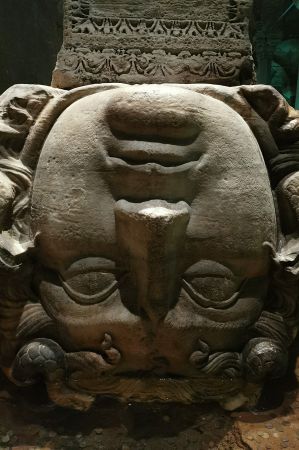 One of the supporting 336 pillars shows a special feature, because it shows some figures that look as if they are crying.
One of the supporting 336 pillars shows a special feature, because it shows some figures that look as if they are crying.
It is still said today that these were the tears of the slaves who died during the construction of the cistern.
This is how the pillars still tell their story today.
In the rear part of the cistern there are two Medusa heads as a foundation for the marble column.
Why one of the medusas is placed upside down and the other sideways will probably remain a mystery forever.
In any case, they were taken from an ancient building from the early Roman period.
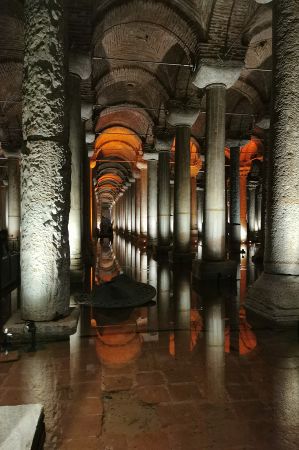 The Basilica Cistern was cleaned and renovated in 1985-1988 and a wooden walkway was installed between the 336 columns by the Istanbul Municipality.
The Basilica Cistern was cleaned and renovated in 1985-1988 and a wooden walkway was installed between the 336 columns by the Istanbul Municipality.
In the meantime, the wooden jetty has long been a thing of the past.
Today a metal lattice frame is installed, which also allows a view down into the water. An absolutely worthwhile destination.
Please also read:
The Ohrid Lake and its bubbling underground springs
Dreiländerbrücke between Weil am Rhein and Huningue
-
 Istanbul - Cistern Sunken Palace
Istanbul - Cistern Sunken Palace
Istanbul - Cistern Sunken Palace
Istanbul - Cistern Sunken Palace
-
 Istanbul - Cistern Sunken Palace
Istanbul - Cistern Sunken Palace
Istanbul - Cistern Sunken Palace
Istanbul - Cistern Sunken Palace
-
 Istanbul - Cistern Sunken Palace
Istanbul - Cistern Sunken Palace
Istanbul - Cistern Sunken Palace
Istanbul - Cistern Sunken Palace
-
 Istanbul - Cistern Sunken Palace
Istanbul - Cistern Sunken Palace
Istanbul - Cistern Sunken Palace
Istanbul - Cistern Sunken Palace
-
 Istanbul - Cistern Sunken Palace
Istanbul - Cistern Sunken Palace
Istanbul - Cistern Sunken Palace
Istanbul - Cistern Sunken Palace
-
 Istanbul - Cistern Sunken Palace
Istanbul - Cistern Sunken Palace
Istanbul - Cistern Sunken Palace
Istanbul - Cistern Sunken Palace
-
 Istanbul - Cistern Sunken Palace
Istanbul - Cistern Sunken Palace
Istanbul - Cistern Sunken Palace
Istanbul - Cistern Sunken Palace
-
 Istanbul - Cistern Sunken Palace
Istanbul - Cistern Sunken Palace
Istanbul - Cistern Sunken Palace
Istanbul - Cistern Sunken Palace
-
 Istanbul - Cistern Sunken Palace
Istanbul - Cistern Sunken Palace
Istanbul - Cistern Sunken Palace
Istanbul - Cistern Sunken Palace
-
 Istanbul - Cistern Sunken Palace
Istanbul - Cistern Sunken Palace
Istanbul - Cistern Sunken Palace
Istanbul - Cistern Sunken Palace
-
 Istanbul - Cistern Sunken Palace
Istanbul - Cistern Sunken Palace
Istanbul - Cistern Sunken Palace
Istanbul - Cistern Sunken Palace
-
 Istanbul - Cistern Sunken Palace
Istanbul - Cistern Sunken Palace
Istanbul - Cistern Sunken Palace
Istanbul - Cistern Sunken Palace
-
 Istanbul - Cistern Sunken Palace
Istanbul - Cistern Sunken Palace
Istanbul - Cistern Sunken Palace
Istanbul - Cistern Sunken Palace
-
 Istanbul - Cistern Sunken Palace
Istanbul - Cistern Sunken Palace
Istanbul - Cistern Sunken Palace
Istanbul - Cistern Sunken Palace
-
 Istanbul - Cistern Sunken Palace
Istanbul - Cistern Sunken Palace
Istanbul - Cistern Sunken Palace
Istanbul - Cistern Sunken Palace
https://www.alaturka.info/en/turkey-country/marmara-region/1680-basilica-cistern-sunken-palace-cistern?tmpl=component&print=1&layout=default#sigProIde04398e226
